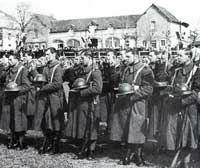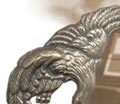 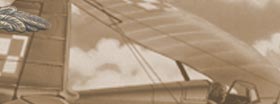  |
||
|
|
Stanislaw Bacia was born on 2nd November 1914 in Bobrowniki, a district of Bedzin-Kielce in the heart of the industrial belt in southern Poland. Franciszek and Bronislawa (nee Sznura) who were property owners lived at Koscielna Street 191, Bedzin and had three other sons. Stanislaw had left Grammar School for a career as a civil servant with a promising future as a teacher. Stanislaw had completed his teacher training at Dobra Gorn not far from home in 1934. Like numerous young men, he also had to complete infantry training which was mandatory in Poland during the inter-war years. On 18th September 1934 he was sent to the officers academy at Zambrow with the initial rank of rifleman. Stanislaw was then posted to the divisional training centre Tarnowski Gory where he was promoted to cadet officer and attached to 11th Infantry Regiment in reserve. Here he practised roles as a squad then platoon leader. As a reservist he trained regularly throughout this period from 1936 right up until the outbreak of war and attaimed the rank of 2nd Lieutenant on 1st January 1938.
Colonel B. Pruger-Ketling commanded the 11th Infantry Regiment and they had been initially mobilized on 31st August 1939. Mobilization had taken place in the Carpathian region as part of Army Krakow and after 9th September they became part of the Army Malopolska. The regimentís duties were split between detachments being sent to Bochina-Brzesko to defend the main route between Krakow and Tarnow to the east. Most of the division was sent to defend Tarnow-Debica area. By 8th September, the division was concentrated just north of the river Jaslo defending the towns of Kolaczyce to Brzostek on a north-south axis before retreating eastwards to the Barycz region just south of Rzeszow where heavy fighting took place between 11th and 12th September. On 13th-14th September they were forced to march further east towards Mosciska (now Mostys'ka in the Ukraine) through Przemysl towards Lwow where heavy bombardment through air strikes slowed progress and caused casualties to both army and the civilian population. On 15th September they entered Sadowe Wisznia then were ordered northeast towards Jaroslaw to engage the SS Germania Regiment in a night attack. Although they defeated the Germans, their losses were severe and they withdrew southeast towards Lelechowka on 18th September. The remnants attempted to flee east towards Lwow and were destroyed as a fighting unit or captured. Individuals escaped by making their way to the Dukla Pass where they were interned in camps in Rumania.
Lwow was a city used to being under siege and remains a 'contested' city due to its location, culture and history. Its history has witnessed the passing of great armies, ranging from the Tartar hordes, countless Russian invasions, through to Napoleon's ill-fated Russian campaign. Subsequent revolts after the collapse of the Napoleonic Empire then saw the city immersed into part of the Austro-Hungarian Empire. The city was a major target for the oft forgotten Polish-Soviet War 1919 ñ 1920 (Davies, 1972; 1979; Zamoyski, 2008).
The defence of the city started on 7th September under the command of Wladyslaw Langner, with General Franciszek Sikorski (brother of General W. Sikorski) taking over from General Rudolf Prich's command of the army covering the whole area. The initial defenses covered a line between Zolkiewand Grodek Jagiellonski using the river San for natural defense. On 10th September the Polish 10th Cavalry Brigade under the command of General Maczek had reached the San only to find the Germans had beaten them to the river crossing and despite a fierce engagement with the Germans, the action only slowed their advance on the city. Stanislaw Bacia was billeted in the Deaf and Dumb Institute from 12th to 15th September on defense duty and could hear various units being engaged in the distance. Militias had been formed to support regular troops with about 10,000 troops committed to the defense of the city. With the fall of the city looking imminent, Stanislaw was ordered to evacuate to Kolmyja by rail on 15th September before being transferred to trucks and crossed the border into Romania on at 11.00am on 18th September 1939.
General Maczek was given the task to keep open a route between Krakowiec-Jaworow-Janow towards Lwow.On 14th September Maczek attacked the Zboiska Heights to the north of the city and after three days of engagement took the fortifications with units re-deployed into the city for its defense (Zaloga and Madej, 1991).
On 11th September the German 1st Mountain Division reached Sambor and the following day attacked the suburbs of the city. Maczek's intervention at Zboiska was a short-lived victory as on 17th September the Soviet Union joined Nazi Germany in partitioning Poland. The Poles were fighting on two fronts and the Romanian Bridgehead was under threat. From 19th September units began to slip through the city and head for the Dukla Pass. Within the city Polish militias fought both Soviet and Nazi aggressors and even the invaders contested the ownership of the city under the Ribbontrop-Molotov agreement.
Stanislaw Bacia crossed the border on 18th September 1939 at 11.00 in the morning with the remnants of the 11th Infantry Regiment under the command of Colonel Boski. Romania interned all Polish soldiers in camps dotted across the country at some of the following locations: Badabag, Kalafatu, Tuluca or Turnu Severin in conditions which ranged from basic to squalid where the lack of food, poor hygiene and malaria took its toll. Pilots and almost all of the Polish Intelligence Section (Section II of the General Staff) were sometimes housed in private homes due to their status and prioritization for evacuation. Some 30,000 military personnel had been interned while the government in exile continued negotiations from Paris. Romania like Hungary came under increasing pressure from Germany over the handling of the escaped military personnel who began to 'slip away' and by October 1939 Sikorski had secured an agreement with France and ordered the evacuation of all military personnel to France. Stanis?aw obtained his passport at the Polish Embassy on 10th October in Bucharest and evacuation orders followed shortly.
Freighters had been 'ordered' to ship the soldiers to Marseilles in southern France from Romania and Yugoslavia. Stanislaw escaped through Yugoslavia and arrived by ship in Marseilles on 20th December 1939. He took a train to Paris and reported to a rallying station where he was sent to Coetquidan in Bretagne.
From December 1939 until 6th April 1940 Stanislaw attended an officers training course at the camp before being posted to the 2nd Division (2DSP) or 2. Dywizja Strzelcow Pieszych in eastern France near Belfort.
The 2nd Division (2DSP) was formed between late December 1939 and May 1940 at Parthenay in France.
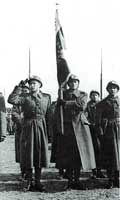
Adopting the colours of 2DSP Parthenay 1940
By the 1st June 1940 2DSP were disembarked at Colombey les Belles some 25Km southwest from Nancy in the region of Lorraine and ordered to complete the journey on foot. The 110Km march to Belfort was made in four stages.The journey was difficult and ill fitting boots and poor physical conditions took its toll on the inexperienced soldiers. Equipment was placed on cars and lorries with the final stage of the march taking place in the cooler conditions of the night. Now under the overall command of the 3rd French Army, the Poles began to construct anti-tank batteries with the battalion of engineers arriving from Angers to assist in their construction. On 8th June at 21.00 there was a suddenly a new set of commands from the French Army. The 2DSP were being integrated with the French 45th Corps under the command of General Darius Daille to re-enforce the Eastern flank in response to the German invasion of France under operation Der Fall Braun. On 9th June orders were received to embark on troop trains located in Vesoul. On 10th June the orders confirmed they were being sent to re-enforce Belfort and loading commenced at 14.00 and was not completed until 18.30 on 13th June. Witnesses described the embarkation as chaotic and lacking overall cohesion with officers having to deal with partial or incomplete plans which complicated the loading (Smolinski, 1992). The first units of the division were disembarked at the railway stations in Belfort, Montbeliard, Lure, Bas-Evette, Hericourt and Morvillars. The disembarkation started on 10th June 14.30 until 16.00 on 13th June into a region where the Poles felt the local population were not welcoming. The 2DSP were quartered in poor conditions with some living in the forests. After the first Luftwaffe attacks on Belfort, the following strikes were aimed at damaging or destroying artillery locations around the city. For two days there were conflicting reports and orders. General Daille confirmed the 2DSP were to spend two days of training and then four days building fortifications around the city. The Polish troops remained disciplined and tidy in appearance and soon won over the local people who were less impressed by the organization of the French forces (Smolinski, 1992).General Daille under pressure from the French General-Staff continued to strengthen fortifications around the city and ignore intelligence reports that the attack would be from the northeast where 25 German Divisions were amassed ready to strike. On 12th June 2DSP received orders for the artillery division and the infantry to be held in reserve (szab polku piechoty). For the next twenty-four hours more questions than answers were raised as the role of the 2DSP appeared vague in terms of role and under whose command they would receive their orders for deployment. By 13th June clarity in role became clearer as the orders were received at 15.00 ordering 2DSP into defensive roles on a north-south axis under the overall command of the French commander General Girol. On night of 13th and 14th June General Pruger-Ketling gave his orders for the 2DSP to take up positions. The northern sector consisting of the 5th Little Poland Infantry Regiment (Malopolski Pulk Strzelcow Pieszych) was to be commanded by Colonel Bronislaw Kowalczewski who also had two French Pioneers Divisions on the line. The southern sector was defended by Lt. Colonel Aleksander Gembal who commanded 4th Warsaw Infantry Regiment (Pulk StrzelcÛw Pieszych) and their task was prepare to counter-attack in the direction of Bouogne. General Prugar-Ketling's initiative was undermined when General Daille succumbed to an order from the French Chief of Staff. The two battalions of French pioneers were withdrawn. 2DSP were now defending the north and eastern approaches to Belfort on an inverted 'L shaped' arc line from Seromagny - Lachappelle sous Rougemont down to Fesches le Chatel - Arcey thereby rendering the Eastern defences useless. On 10.00 14th June 1940 the German 444th Infantry Regiment crossed the Rhine at Colmar. The French General Staff still considered the main threat to Belfort from the east between the Swiss - German Border. On 15th June the main German attack came northeast from Vesoul and Gray. As the attack was launched, the 6th Infantry Regiment (6 Pulk Piechoty) received orders to hold their eastern positions while half an hour later in the confusion of battle unit commanders received orders to swing their defences to the west. Confusion continued for the next twenty-four hours. On 16th June at 06.30 General Pruger-Ketlingenforced closure of the roads Hericourt - Belfort and Frahier et Chatebier - Belfort. At 07.00 an order was given for an infantry battalion consisting of three battalions from the 6th Infantry Regiment and one from the 4th Infantry Regiment together with three artillery divisions to stay and defend Belfort while the rest of the division should march south in the direction of Besancon to keep open a route for the main forces from the west. General Pruger-Ketling disliked the order to fragment and dismember the division and waste valuable time removing troops from the line who were needed to defend Belfort (Smolinski, 1992). Pruger-Ketling recommended a counter-attack to the east by the whole division (without the 5th Regiment and reconnaissance division). Although Prugar-Ketlingís alternative proposition was accepted, nothing materialized. Orders came for the 2DSP to march south towards Rioz. The size of the column including the 116th Heavy Artillery made the plan a potential massacre as the troops were an easy target for the Luftwaffe. As the situation deteriorated, General Daille ordered the 2DSP south towards Besancon during the night of 16th/ 17th June in two columns. Panzer Divisions' under the command of General Heinz Guderian were attempting to strike through the retreating columns. Directed from Guderian's HQ based in Langres, the situation for the retreating columns became increasingly tenuous. Despite physical exhaustion the 2DSP arrived at Pont de Roide and hid in the in the forests surrounding the village. The 6th Infantry Regiment (6 Pulk Piechoty) were given separate orders to move and defend the bridge at Colombier Fontaine, at that time a key bridge needed to remain intact for the eastward advance. As a commander of an independent commando platoon, Stanislaw's role was to ensure his unit secured gaps in the over stretched defensive lines in the Belfort gap - Doub Forest. On 15th June the 6thInfantry Regiment (6 Pulk Piechoty) were defending the eastern line from the village of Denney to the town of Bessoncourt with the impressive fortress of Belfort behind them to the west. The original defensive line stretched south to Montbeliard. By 17th June Stanislaw's unit were responding to the separate orders to move and defend the bridge at Colombier Fontaine - a forced march of some 37Kms in un-ideal conditions. Digging in to defend the bridge, the commando unit had the canalized section of the River Doub to the front as a barrier and the surrounding forests for cover. It is not clear how long they held their position, but they were most likely ordered to retreat to Saint Hypollyte on the night of 16th and 17th June and most likely blew the bridge on their retreat. On 17th June at 06.45 the remaining units of the 2DSP were ordered to move towards Belleherbe - Maiche via Saint Hypollyte in order to protect the transport network and their escape route into Switzerland.
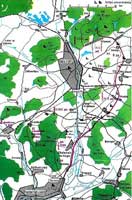
The terrain of the Doub was ideal for defensive work, but difficult for over-stretched units with poor transport and communications. On 16th June the Germans broke through the Champagne to Dijon Front with units of the 19th Panzer Korps reaching Besancon and the 23rd Infantry Division under the command of Lt. General Heinz Hellmich attacking east towards Belfort.
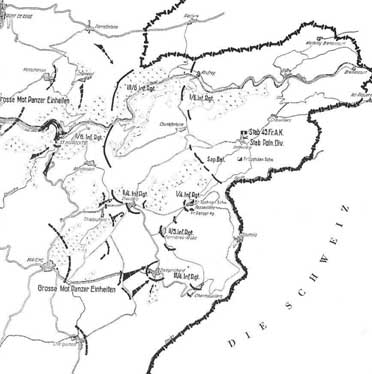
With the German breakthrough in the evening of 16th June, the roads became clogged with escaping units of the French 8th Army and 45th Army Corps. Many of these units panicked and fled in disarray disposing of arms and equipment along the route. Remnants of these units set up defensive lines between the river Creuse and Reverotte. The fleeing columns were being funnelled through St. Hypollyte towards Maicheor towards Pontalier on narrow roads typical of this part of the Jura, which also constrained and frustrated the German advance. On 17th June Polish units received orders to close the Doub valley above Bief towards Pierrefontaine les Blamont as well as the Dessoubre valley in an attempt to allow French forces to reposition close to the Swiss border at Indevillers. The 6th Infantry Regiment under the command of Lieutenant Bien was to defend the northern sector of St. Hypollite - Montandon and was joined by French Saphis units who fought hard and did not break the line. German units were penetrating through the forests towards Saint Hypollite in an attempt to outflank the Poles. The first contact with German armoured units was at 13.30 at Frambouhans to the southwest of Maiche where they attempted to break through and were halted by fierce fighting. The Saphis units eventually crumbled under the weight of the attack and the Germans began to outflank the 1st Battalion through the forests. Artillery barrages by the 1st Light Artillery Division supporting the 1st Battalion kept the attack at bay and enabled the evacuation of Maiche at 22.30. On the evening of 17th June senior officers had checked on the condition of the men and levels of ammunition. General Pruger-Ketling reported the serious deteriorating conditions to General Darius Daille who concluded that an escape to the south of France was now impossible. General Pruger-Ketling went to the front line in the forests of Clos du Doub to inspect the conditions in this sector. On returning to his HQ the plans for the mass evacuation to Switzerland were put in place for the night of 19th to 20th June. The 6th Regiment had staunchly defended Saint Hypollite and its bridge over the River Doub in order to allow retreating units to escape east. They sustained heavy casualties after an engagement with a large formation of Panzer units with a simultaneous attack towards Pontalier. Saint Hypollite was in flames and constant artillery barrages destroyed most of the houses leaving its defensive positions in constant danger of being outflanked and over-run. 2nd Lieutenant Bien had been asked to mount the final defence of the village with an anti-tank unit supported by the 2nd Light Artillery Regiment until the morning of the 19th June in order to enable the evacuation of troops to the Swiss border. In the ëheat of battleí many Polish units escaped through luck and the confusion caused by thick smoke and the melee of soldiers and civilians trying to escape. The 6th Regiment had inflicted heavy losses on the Germans. As the battle died down from 17.00 onwards, the regiment was ordered to retreat. As they evacuated Saint Hypollite, they blew the bridge at Soulce and opened up the dam near Vaufrey to flood the valley in order to hamper the German advance. They crossed into Switzerland near Montjoie-le-Chateau. It was in the defence of this important bridge that Stanislaw most likely won his gallantry medal (Virtuti Militari). He stepped forward as a volunteer to hold this strategic bridge and its surrounds to enable as many as possible of his Division to escape into Switzerland. Charged with keeping the escape route open for twelve hours, Stanislaw and his small group of soldiers managed to hold their position for twenty-four hours. Many eyewitnesses later recalled that the intensity of battle at Saint Hypollite was such that German soldiers mistook the Polish and French units as their own and thereby enabled more to escape imminent death or imprisonment in a POW camp fmr the duration of the war. With the fall of France the 2nd Division (2DSP) decided to escape across the border into Switzerland on the 20 - 21st June 1940 ad St. Ursanne, crossing th£ River Doub and using the forests for cnver (Praz, 1995). At the border the Polish soldiers abandoned their arms `nd became interned under the control and protection of General Henri Guisan. The French government under Paul Reyjaud resigned leaving Marshall Petain as successor to sue for peace. Internment in SwitzerlandFrom 21st June 1940 until 23rd February 1945 Stanislaw was interned in Switzerland. About 12,000 men had escaped, which in doing so placed Switzerland in a precarious position within Nazi occupied Europe. To minimise political and diplomatic tension with Germany, the Commissaire federal a l'internment et hospitalisation decided to construct a mass internment camp at Buren in the Canton of Solothurn to partially contain the Poles and remove local tensions as the Swiss men were away from home defending their border. Nazi Germany had planned to invade Switzerland under operational plan "Tannenbaum" prior to the outbreak of war in Europe. The Swiss under General Henri Guisan had also mobilized civil defence forces such was the threat (Praz, 1995; Falletti, 2007), so the need to keep the Poles' activities in check was quite real. Indeed in 1943 the Nazis revised their invasion plans under Operation "Boehme" (Garlinski, 1981). The Swiss authorities employed the Poles on farms, forests, factories or mines and the relationship settled down after initial tension in December 1940 when riots were quelled and a number of Poles were shot and wounded. Additional camps were built for example at Huttwil and Oberburg to ease pressures with satellite camps spread out throughout Switzerland, particularly where there were road and bridge construction projects in the mountains. Switzerland was encircled and under "Plan Wahlen" all available space was utilized for growing food with the young Poles assisting the Swiss.
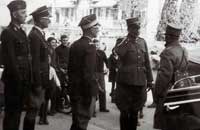
General Guisan meets Brigadier-General Bronislaw Pruger-Ketling 1941. Interned in the village of Bettenhausen, Stanislaw approached the authorities to set up a school so that the younger Polish soldiers could continue their interrupted education. Under internal re-organization, the Polish-Swiss authorities created 7 sectors for the management and control in the internment camps. An 8th sector was created in December 1941 to cover university education, which entitled them to create smaller satellite camps in order to place the students in the universities at Zurich and Fribourg to continue with their education. Students were required to continue wearing their uniforms and integrated well with their Swiss cohorts. By 1945 900 students had completed their studies with a further 300 finishing their chosen degrees. Those students who had not graduated from high school (Lycee) were able to return to study through a Polish - Swiss initiative. A Lyceum was created in Oberburg in February 1941 and then later moved to Wetzikon. Although based on the Polish secondary education system, the Swiss authorities allowed independence within the curriculum and a joint commission enabled the baccalaureates awarded and recognized in the Swiss Universities of Applied Sciences (HES/UAS) to allow progression towards a bachelor degree. Over 400 students enrolled and 185 obtained their 'maturite' by the end of the war. Re-enlistment 1914After the D-Day landings in Normandy in June 1944, the interned Poles watched carefully the Allies progress through northern France. Once the landings of Operation Dragoon on 15th August started in southern France and the thrust had reached major cities like Lyon, many interned Poles escaped over the border despite their pledge to the Swiss. Stanislaw escaped on 23rd February 1945 and re-joined the Polish Army under British command as a 1st Lieutenant in the 2nd Infantry Brigade. Eventually transferred to the UK, Stanislaw landed at Southampton on March 8 1945. On 1st January 1946 he was promoted to Captain prior to joining the Polish Resettlement Corps. Based in Peterhead, Scotland, he again ran a school for young Polish soldiers, including those who had been taken as slave labour to Germany. Stanislaw Bacia was honourably discharged on 7th March 1947.Postscript

Dad in bow tie on left, mother in wrap beside him - SPK ball in Brisbane

Dad speaking at SPK clubhouse. I asked if when they did the extensions they coul keep some of this railing.

Dad with me in Scotland.

One of his brothers,Tadeusz Bacia, was imprisoned as a political prisoner before being sent to Germany as a slave labourer. He survived the war.
Father to Jennifer and Suzanne, Stanislaw Bacia was a successful businessman and instrumental in establishing his State branch of the SPK (Polish Ex-servicemenís Association) He was President twice before dying prematurely of a heart attack in 1969.
|
|
Site hosting by Paston.
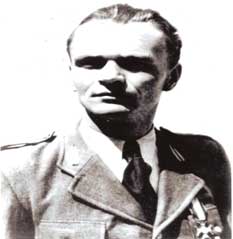 The following section has been kindly donated by Jennifer Bacia.
The following section has been kindly donated by Jennifer Bacia.
